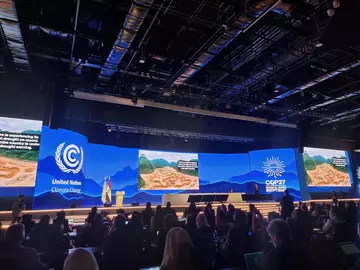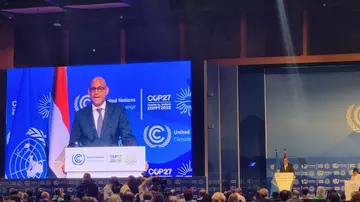
Bethan Laughlin
Senior Policy Specialist
ZSL’s Senior Policy Specialist Bethan Laughlin reflects on the outcomes of the United Nations Convention on Climate Change’s COP27 and what it means for nature.

Sharm El Skeik, the host city of COP27, sits on the edge of the Sinai desert, with brick red mountains stretching across the horizon in almost every direction. If you turn towards the ocean, an outcrop of small mountainous islands greets you. These islands, part of Saudi Arabia, have proven to be something of an ever-present reminder to me of how close we are, on the edge of Egypt, to the heartland of the Gulf States and their fossil fuel producing legacy. In the shadow of these mountains, the United Nations Framework Convention on Climate Change - COP27 - has taken place, attempting to bring countries together to not only agree on the need for action against the threat of climate change, but to deliver on it.
In the early hours of the morning of the 20th November, more than 24 hours after proceedings were due to close, the final plenary meeting of COP27 took place and “gavelled in” a range of decisions that were reached over the two weeks; following a frenetic final 42 hours of divisive, and at some points fraught, negotiations between member states on several major areas.
Disagreement is a central part of any negotiation, but as the UNFCCC moves into a new era of implementation, COP27 has been something of test for whether the UNFCCC can stay relevant as a mechanism for effective implementation. Proceedings were not aided by logistical issues running throughout the two weeks, impacting morale during the vital negotiations, and tensions could be felt as the UNFCCC’s processes and staff reckoned with its new purpose of implementing promises rather than just making them.
Although some major agreements were made at COP27, freeing up financing to enable this implementation was a major sticking point alongside scaling up decarbonisation commitments and will likely remain so in coming years.

Was COP27 a success for nature?
Nature at COP27 has been something of a mixed bag. Over the course of the two weeks there have been hundreds of side events, pavilion talks and speeches on the role of nature and biodiversity as a tool in the toolbox for the task of tackling the climate crisis. As states try to move towards implementation, investment in Nature-based Solutions (NbS) was regularly spoken about as an essential component of mitigation and adaptation that should sit alongside wide scale decarbonisation of energy systems.
The COP27 Cover Decision – titled the Sharm el-Sheikh Implementation Plan - is a short document that outlines the main outcomes of negotiations and areas that member states wish to highlight. This year, the text saw a number of positive firsts for nature.
Within the text there are dedicated sections devoted to Forests and Oceans, alongside the first ever mention of “tipping points” for the glaciers and ice caps, and the term “Nature-based Solutions and ecosystem approaches” included for the first time. The drafting of cover texts is highly political and often comes down to the last possible moment of the negotiations, so inclusion of biodiversity focused language represents a significant shift in the integration of nature into UNFCCC texts. The inclusion of nature-based solutions in particular is a win after its previous removal from The Glasgow Climate Pact at COP26 during the negotiations.
However, it is not all good news. Despite a strong push by many nature focused NGO’s to see reference to the upcoming Convention on Biological Diversity (CBD) COP15 included in the text, stressing the need for an ambitious science-led Framework on Biological Diversity to be agreed at the upcoming conference, the language did not make it through the negotiations and into the text. This would have shown an international will to see a successful agreement on tackling the biodiversity crisis, so its lack of inclusion is a blow to those who wish to see the upcoming COP15 negotiations result in a strong agreement on global action against the biodiversity crisis.

Disappointing progress on scaling up of decarbonisation
In a last-minute change to the text, the term “low emission and renewable energy” has been included and has caused concerns that it may be broad enough to leave the loophole that will enable gas to be considered “low emission” in comparison to oil and coal. After a push from fossil fuel producing states, there is no reference to oil or gas as the causes of emissions and only one reference to coal. This is a long-term issue within the UNFCCC, with fossil fuel producing states having a red line on using the names of fossil fuel sources, rather wishing to focus on “emissions”. This use of language is akin to trying to have a conversation about the economy but being forbidden to use the word “money”. Like all things in the UNFCCC these highly technical discussions on the specifics of language are incredibly significant for how countries will be encouraged and motivated to decarbonise, rather than just invest in technologies like Carbon Capture and Storage (CCS) which are at present unproven on a large scale and is seen as a “get out of jail free card” for emitters as they claim they can simply capture and store the carbon emitted rather than address the source of the issues.
In short, this COP has been a failure on delivering on stronger emission and fossil fuel reduction targets needed to fully realise the Paris Agreements 1.5C goal, Without major action in the next year, this goal is at risk of failing all together without major action in the next year, with detrimental impacts for wildlife.
Loss and Damage – a boost for climate justice
Despite this, one major area of success was the passage of an agreement on Loss and Damage Financing. A deal being struck on this should not be overstated as an enormous achievement. Even its inclusion in the agenda on the opening day of negotiations was uncertain until the last possible moment. What has been agreed at COP27 is the creation of a “Loss and Damage Fund”, designed to compensate and support developing countries who have seen major losses and damages due to the impacts of climate change. It has been a divisive topic, as developing states feel economic support from the historic green house gas emitters should be paid to those countries who have done the least to cause climate change but are suffering the most from its impacts. Its passage was a success, but the major question remains of how the financing for this “fund” will be collected and who will be asked to pay up; with concerns that rich nations will find loopholes to not contribute.
For nature and biodiversity, Loss and Damage is an important area, as the losses and damages incurred by climate vulnerable states are intrinsically linked to the destruction of natural capital, ecosystems, and agricultural land, not to mention the cultural links to nature that permeate every culture. As discussions move on over the coming year to how loss and damage funds will be mobilised and paid, the role of nature should not be underestimated.
Final Thoughts
This COP feels like a negotiation of two halves. Firstly, the passage of an incredibly significant agreement on loss and damage financing, a call that has been made by developing states for decades and has finally been realised. Yet this comes alongside lacklustre success on the vital task of scaling up emissions and fossil fuel targets. Without major action on decarbonisation, a Loss and Damage fund, however successful, will do nothing against the devastating impacts of climate change on people, planet, and nature.
COP 27, followed by COP 19 in Panama in November and COP15 in Montreal in December, will together put a much-needed spotlight on the decline in global biodiversity.
But without coordinated nature-based policies in place across the world, animals will continue to go extinct, ecosystems will continue to break down and climate change will continue to change life on earth as we know it.
It is vital that governments commit to using nature-based solutions - rooted in science from ZSL and organisations like it - to tackle the combined threats of climate change, biodiversity loss and public health crises.
It is with science that those in power must start: throughout conference season, ZSL is calling for world leaders to put nature at the heart of all global decision-making to better protect ecosystems, wildlife and the communities who rely on them.
Support ZSL's global science and conservation work and find out more
Climate change and human activity have pushed our precious planet to its limit, causing the devastating loss of so many habitats and species. From lab to field, hands on and behind the scenes, we’re leading the future of conservation, shaping agendas and influencing change to support better life, health and living for people and wildlife.
